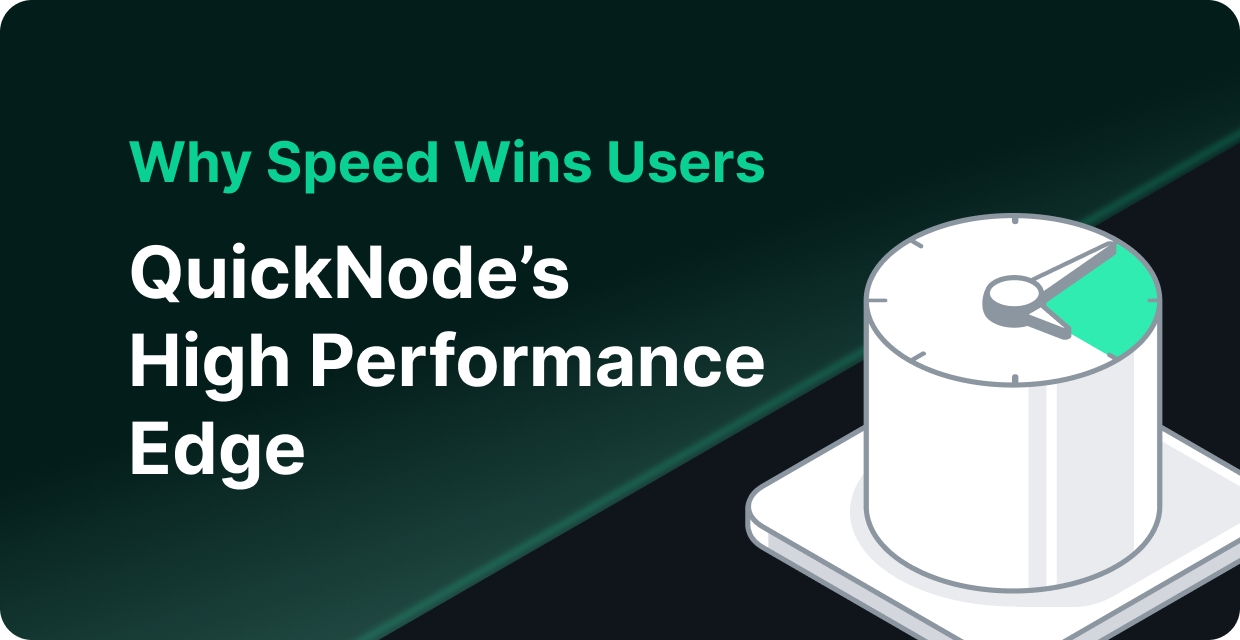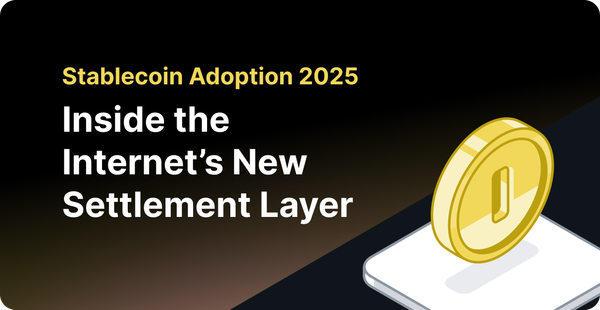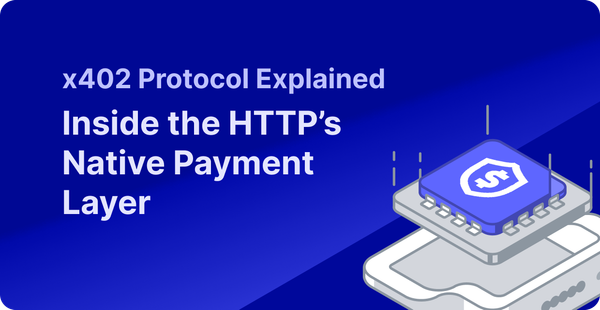Speed Wins Users: The Web3 Dapp Performance Playbook
Speed is the most common growth lever web3 teams overlook. Learn how faster dapps convert, retain, and build user trust.

Speed is invisible when it works and unforgivable when it doesn’t. We’ve all closed a tab or abandoned a checkout because it took just a few seconds too long to load.
The same impatience applies to web3: wallet connects, swaps, portfolio updates. If they feel slow, users assume something’s broken and move on.
This blog unravels the hard truth about speed and how to navigate the latency headache and turn speed into a growth and trust lever for dapps.
The Universal UX Law: Speed; Wins Users
The math is simple and unforgiving: users don’t wait.
This is not a web3 problem or a blockchain quirk, it's a universal law of digital experience that questions everything from Amazon checkout to Google search.
The evidence is overwhelming:
- HubSpot: Bounce rate jumps 32% when page load time stretches from 1 to 3 seconds.
- Yelp: Saw a 15% lift in conversions by cutting latency and optimizing both backend and frontend interactions.
- Deloitte: A mere 0.1s speed boost led to 9.1% more users adding items to their cart.
- Akamai: Just a 100ms delay can shrink conversion rates by up to 7%.
- Google: 53% of mobile users abandon a site that takes longer than 3 seconds to load.
- Cloudflare: Pages loading in 2.4s averaged a 1.9% conversion rate, but at 5.7s+, conversion plunged to 0.6%.
Iterating again, the universal law is simple: speed wins users.
And this law doesn’t change just because an app runs on a blockchain. Web3 dapps, protocols, exchanges, wallets, and everything in between need to understand this.
The only difference is the stakes of latency just show up in different places:
- MetaMask takes forever to connect, and the user just moves on to another wallet or walks away from the trade itself.
- DeFi traders watching their swap estimate refresh every few seconds while prices move against them.
- Users trying to mint an NFT during a drop and the transaction just never goes through.
Each of these instances carries the same
- psychological triggers
- abandonment thresholds
- conversion curves, which makes people abandon Amazon carts during slow checkout.
Now, how can we increase responsiveness and reduce latency for dapps?
Before jumping into fixes and checklists, it’s essential to step back and examine the fundamentals. Infrastructure design and choices significantly shape the user experience, which directly influences key metrics such as conversion, retention, and TVL.
Understanding Infra > UX > Growth: The Ladder Actually Moves Metrics
Remember this: Every infrastructure decision ripples through user experience and ultimately the reliability of WebSockets growth metrics.
Let’s think of a simple ladder:
- At the bottom is infrastructure. This covers RPC latency, the reliability of websockets, whether the dapp has multi-region failover, and how well the dapp or protocol handles traffic spikes.
- In the middle is user experience. The infrastructure either makes interactions feel instant, like transactions confirming quickly and dashboards updating live, or it makes them feel stuck and unreliable.
- At the top are growth metrics. The infrastructure either makes interactions feel instant, like transactions confirming quickly and dashboards updating live, or it makes them feel stuck and unreliable. longer, and trusting the dapp with larger balances.
The beauty of this ladder is its compounding nature. Each infrastructure improvement amplifies the others.
Fast RPC calls combined with smart caching and reliable WebSockets create user experiences that feel magical compared to slow, unreliable competitors.
The ladder of Infra > UX > Growth is the lens every web3 team should use to measure performance.
Now, the next question is obvious: how do you actually keep a dapp fast and trustworthy without getting bogged down; in technical details?
How to Keep Dapps Fast and Trustworthy (The 20% That Drives 80%)
The difference between fast and slow dapps isn't rocket science; it is just good, old prioritization. Some changes deliver almost no user-visible benefit, while a handful drive the majority of wins.
To focus on the vital few improvements that users actually feel, here is a systematic approach that works:
Measure What Actually Matters
Measurement = Improvement. Let's track the latency and responsiveness that actually decide whether users stick or leave.
- TTFB (Time to First Byte): Measuring how quickly the server responds to requests.
Anything over 600ms feels sluggish. Under 200ms feels instant. This single metric predicts bounce rates better than almost any other.
- Core web vitals: Google's three key metrics directly correlate with user satisfaction.
- LCP (Largest Contentful Paint) should hit under 2.5 seconds.
- INP (Interaction to Next Paint) needs to stay below 200ms.
- CLS (Cumulative Layout Shift) must remain under 0.1 to avoid jumpy interfaces.
- RPC P95 latency: Track the 95th percentile of RPC response times, not averages.
- If 95% of blockchain calls complete under 100ms, users experience consistent performance.
- If the P95 hits 500ms+, expect frustrated users and abandoned transactions.
- Transaction success rates: Monitor what percentage of submitted transactions actually complete.
During network congestion, success rates can plummet to 25% on some chains. Users paying gas fees for failed transactions don't come back.
A simple dashboard that tracks these four metrics will tell you more about real user experience than a dozen other analytics combined.
Dapp Fixes That Actually Move the Needle
These are the changes that consistently eliminate the biggest sources of latency and shift how fast a dapp feels.
- Batch RPC calls: Instead of making 10 separate calls to fetch user data, bundle them into 1-2 requests. This reduces network round-trip times from 3+ seconds to under 500ms.
- Event-driven updates: Utilize WebSockets to push real-time updates instead of polling APIs at regular intervals.
- Smart caching architecture: Cache frequently requested data in Redis. Store complex queries in PostgreSQL replicas.
Only hit expensive RPC endpoints for fresh data.
- Global infrastructure: Deploy across multiple regions with automatic failover. When one region experiences issues, traffic routes to healthy alternatives within seconds.
QuickNode offers built-in multi-region failover and global edge networks, eliminating the complexity of building these systems in-house.
- Design for optimism: Show immediate feedback when users click—spinners, pending states, skeleton screens. Never let them wonder if the app froze.
Habits That Keep Dapps Fast and Responsive
Maintaining high-speed and performance over time is the biggest growth unlock for any web3 dapp or protocol. For this, good habits and routines are a must-have:
- Weekly performance reviews: This can be as simple as answering three questions: what slowed, where did users drop, what’s the top fix to ship?
Catch performance regressions before they impact users.
- Failover drills: Assume infra will fail at some point and test backup systems regularly.
Simulate outages or spikes to test multi-region setups and verify seamless traffic switches.
- No blank states policy: Design interfaces to always show something useful, like progress bars, during loads.
Even the illusion of speed keeps users engaged.
- Performance enforcements: Set hard limits on bundle sizes, third-party scripts, and API response times.
When new features push performance below thresholds, either optimize or don't ship.
Together, these three parts form a playbook: measure the few key metrics, fix the few critical bottlenecks, and adopt the few essential habits that prevent decay.
Even doing these sincerely will ensure that dapps feel fast and more trustworthy than most of the market.
So far, we have only understood the principles: measure what matters, fix what users actually feel, and adopt habits that prevent performance from decaying.
But principles only go so far. That’s where the Founder’s cheat sheet comes to the rescue.
The Ultimate Dapp Founder’s Cheat Sheet to Audit Speed and Latency
The checklist below is designed for product leads and founders to test, validate, and keep teams accountable. It includes actions such as conducting quarterly failover drills and dependency audits.
Frontend Performance
✅ Always show skeletons or content within 2s — never a blank screen.
✅ Use optimized images (WebP, <100KB each).
✅ Keep the JS bundle under 500KB and cut unused scripts.
✅ Run Lighthouse/PageSpeed: LCP < 2.5s, TTFB < 600ms.
Mobile Experience
✅ App works on a throttled 3G/4G connection without breaking core flows.
✅ Tap targets are 44px+ with no horizontal scrolling.
✅ Test monthly on a mid-tier Android phone (and in a wallet browser). Load should feel useful in <3s.
User Flow
✅ No critical action requires a page refresh (swap, stake, claim).
✅ Every click shows instant feedback (spinner, progress bar, pending state).
✅ Wallet connect → ready to transact in ≤30s, with clear retry if it fails.
Data Refresh
✅ Stale data shows a timestamp so users know when it was last updated.
✅ Price feeds/market data refresh without user input.
✅ Balances and positions update automatically (WebSockets or smart polling).
Reliability and Failover
✅ Clear, human-readable error messages with next steps (“Add more gas,” “Retry”).
✅ Simulate an outage once a quarter to confirm smooth switching.
✅ Multi-region RPC providers configured; auto-failover tested quarterly.
Monitoring and Alerts
✅ Review error logs and user-visible failures weekly.
✅ Alerts fire if RPC p95 > 500ms or Tx success < 90%.
✅ Track 4 core metrics in production: TTFB, Core Web Vitals, RPC p95 latency, Tx success %.
Maintenance
✅ Conduct quarterly failover drills and dependency audits.
✅ Mobile testing on real devices monthly.
✅ Bi-weekly performance review: what slowed, where did users drop, what fixes to ship.
If the checklist feels overwhelming, here’s the good news: builders don’t have to start from scratch.
Similar to how the fastest way to lose users is to make them wait, the fastest way to build reliability is to build on infrastructure that is already optimized for speed and resilience. Teams don’t need to reinvent nodes, caching, or failover themselves. QuickNode offers them all a head start.
QuickNode: Infrastructure That Makes Dapps Fast from Day One
QuickNode, out of the box, offers global low-latency edges, autoscaling RPC, reliable WebSockets, and data streaming and indexing solutions. All these factors together help QuickNode deliver 2x+ latency improvements over peers, which directly translate into higher conversion rates and user retention.
More importantly, QuickNode also handles the operational complexity that kills team velocity: automatic multi-region failover, elastic scaling, and 99.99% uptime SLAs.
What You Can Do with QuickNode
- Deploy and scale RPC endpoints across 70+ blockchains with enterprise-grade performance.
- Reduce latency and improve reliability for your dapps with globally distributed infrastructure.
- Access WebSocket, Webhook, and Streams APIs for real-time data and event monitoring.
- Test, debug, and optimize your protocols or applications with advanced analytics and monitoring.
- Build production-ready apps faster with SDKs, templates, and enterprise support.
Now, the final step is to zoom out and remember why all of this matters.
Speed Builds Trust and Trust Builds Growth
The universal law hasn’t changed: users don’t wait.
In web2, that meant faster pages drove more clicks and sales. In web3, it means faster dapps drive higher activation, stronger retention, and deeper trust.
Every millisecond saved ripples upward through the infra > UX > growth ladder. And lastly, these all culminate in users trusting the dapp
The trust advantage compounds over time.
- Fast applications attract more users, retain more capital, and generate more transaction volume,
- Network effects amplify: users recommend reliable platforms to friends,
- Developers build on responsive infrastructure, and capital flows toward applications that simply work better.
The path forward is clear: measure what matters, fix what moves the needle, and maintain performance through disciplined habits.
About QuickNode
QuickNode provides the tools and resources builders need to create incredible products. With a globally balanced infrastructure, guaranteed reliability, a user-friendly interface, and end-to-end customer support, QuickNode enables enterprises to rapidly bring their ideas to life on the blockchain.





